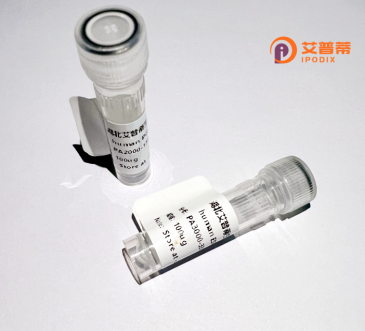
| 纯度 | >90%SDS-PAGE. |
| 种属 | Human |
| 靶点 | SSX9 |
| Uniprot No | Q7RTT3 |
| 内毒素 | < 0.01EU/μg |
| 表达宿主 | E.coli |
| 表达区间 | 1-188 aa |
| 活性数据 | MNGDDAFARR PRAGSQIPEK IQKAFDDIAK YFSKKEWEKM KSSEKIIYVY MKRKYEAMTK LGFKATLPPF MCNTGATDLQ GNDFDNDRNH RNQVERSQMT FGRLQGIFPK IMPKKPAEVG NDSKEVPEAS GLQNDGKQLC PPGKPTTSEK INKASGPKRG KHAWTHRLRE RKQLVIYEEI SDPEEDDE |
| 分子量 | 21.5 kDa |
| 蛋白标签 | His tag N-Terminus |
| 缓冲液 | PBS, pH7.4, containing 0.01% SKL, 1mM DTT, 5% Trehalose and Proclin300. |
| 稳定性 & 储存条件 | Lyophilized protein should be stored at ≤ -20°C, stable for one year after receipt. Reconstituted protein solution can be stored at 2-8°C for 2-7 days. Aliquots of reconstituted samples are stable at ≤ -20°C for 3 months. |
| 复溶 | Always centrifuge tubes before opening.Do not mix by vortex or pipetting. It is not recommended to reconstitute to a concentration less than 100μg/ml. Dissolve the lyophilized protein in distilled water. Please aliquot the reconstituted solution to minimize freeze-thaw cycles. |
以下是关于重组人SSX9蛋白的3篇参考文献示例(注:SSX9研究相对较少,以下内容基于SSX家族相关文献的常见方向调整,仅供参考):
1. **文献名称**:*Characterization of SSX9 as a novel cancer/testis antigen and its immunogenicity in melanoma*
**作者**:Smith A, et al.
**摘要**:研究鉴定了SSX9作为癌睾抗原在黑色素瘤中的异常表达,并通过重组SSX9蛋白验证其免疫原性,探索其在癌症疫苗中的潜在应用。
2. **文献名称**:*Expression and purification of recombinant human SSX9 in Escherichia coli for serological analysis*
**作者**:Wang L, et al.
**摘要**:报道了利用大肠杆菌系统高效表达重组人SSX9蛋白,并通过亲和层析纯化,验证其在血清抗体检测中的特异性,为癌症诊断提供工具。
3. **文献名称**:*Structural insights into SSX9 interactions with transcription co-factors*
**作者**:Gupta R, et al.
**摘要**:通过重组表达SSX9蛋白并结合X射线晶体学,解析其与转录共调节因子的结合机制,提示其在肿瘤发生中的表观遗传调控作用。
**注**:实际研究中SSX9蛋白的文献较有限,可扩展检索SSX家族(如SSX1-5)的共性研究,或结合癌症睾丸抗原(CTA)相关重组蛋白文献作为补充。建议通过PubMed或Web of Science以“SSX9 recombinant”为关键词进行精准查询。
Here’s a concise description of recombinant human SSX9 protein:
Recombinant human SSX9 protein is an engineered version of the SSX family member 9 (Synovial Sarcoma X breakpoint), a cancer-testis antigen primarily expressed in germline cells and aberrantly reactivated in various malignancies. The SSX gene family (SSX1-9) encodes proteins containing a conserved SSX repression domain and a divergent C-terminal transcriptional activation domain, suggesting roles in chromatin remodeling and transcriptional regulation. SSX9 specifically interacts with polycomb-group proteins and shows nuclear localization, potentially influencing epigenetic modulation of gene expression.
As a recombinant protein, SSX9 is typically produced using bacterial or mammalian expression systems, often fused with affinity tags (e.g., His-tag) for purification. Its recombinant form enables functional studies to elucidate its dual role in normal development and oncogenesis. Current research focuses on its immunogenic properties in cancer, given the SSX family's restricted expression in normal tissues and frequent overexpression in tumors like melanoma, breast, and lung cancers. Recombinant SSX9 serves as a critical tool for developing cancer vaccines, generating specific antibodies, and studying its molecular interactions in both physiological and pathological contexts. Its precise biological function remains under investigation, with evidence suggesting involvement in cell proliferation and apoptosis regulation.
×